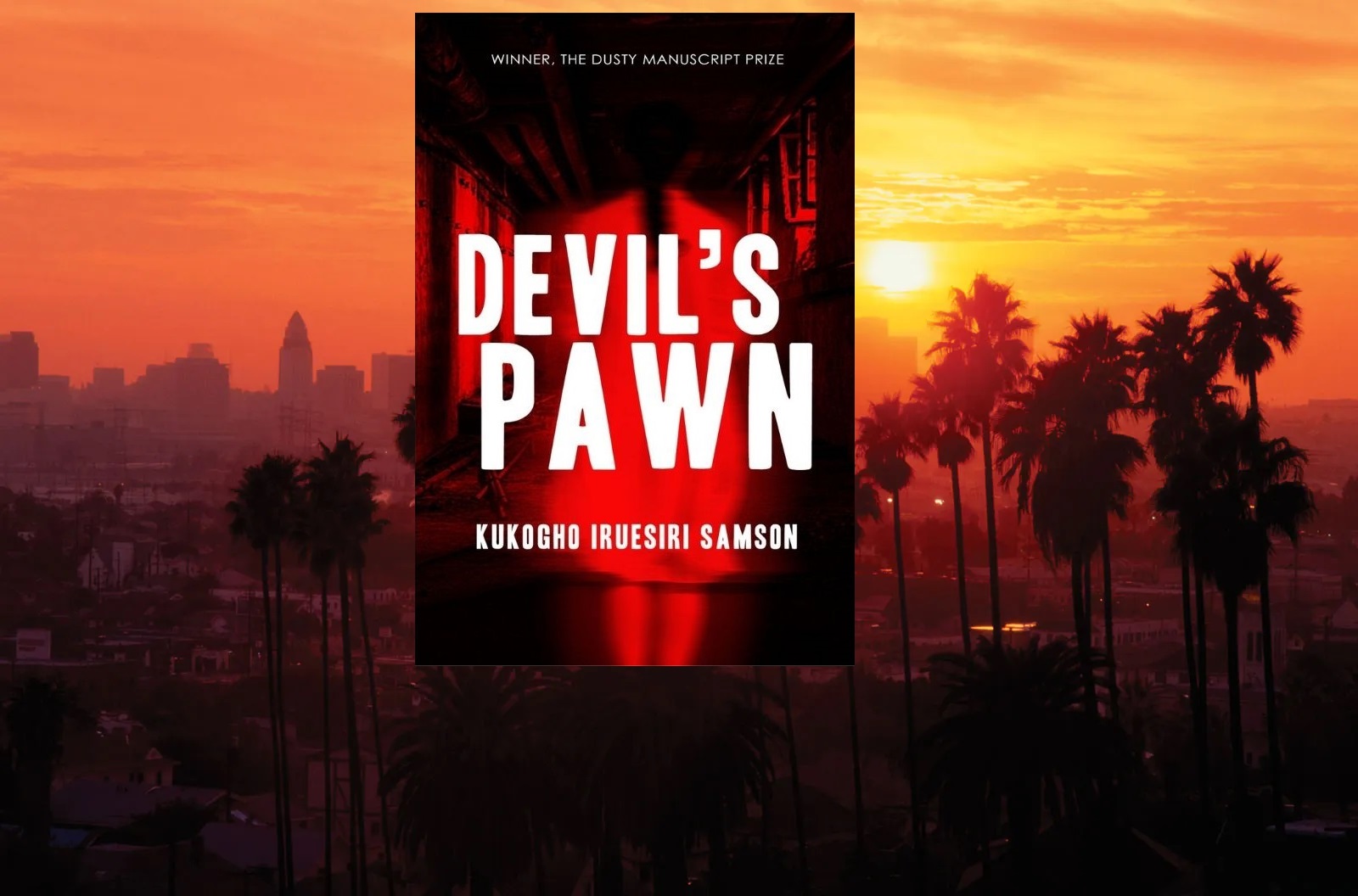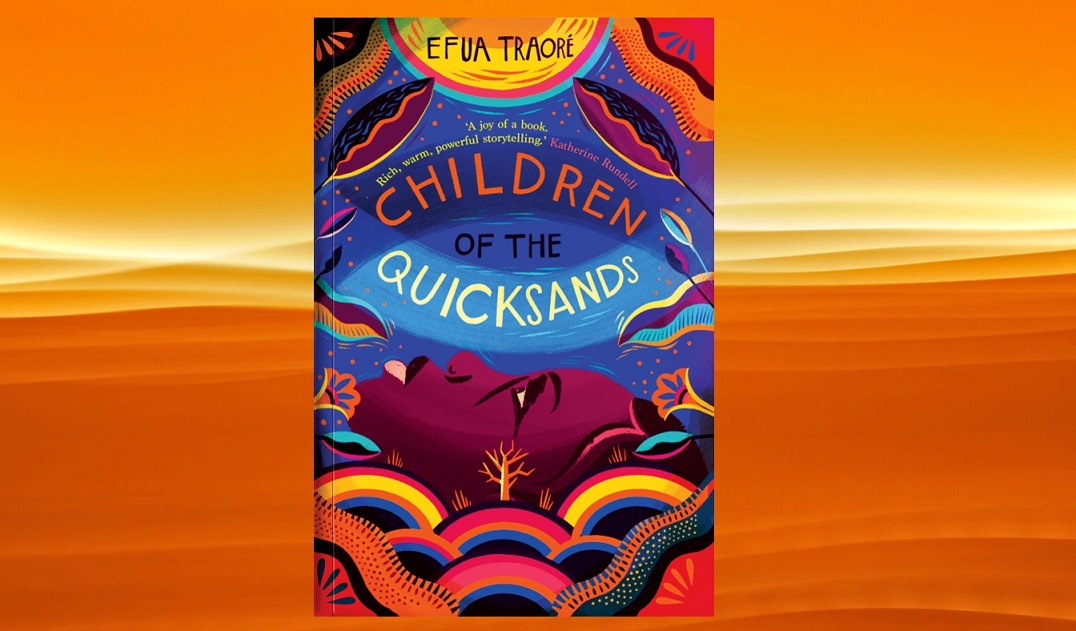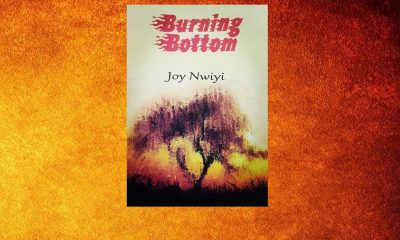BOOKS
A pun star cometh: A review of Sati Gomwalk’s ‘Garden of Thorns’
Published
2 years agoon
By
Geek Afrique
A new collection of poetry shows the many ways in which words can be used or ‘abused’, resulting sometimes in the most intricately-woven work.
Title: Garden of Thorns
Author: Lengshak Sati Gomwalk
Genre: Poetry
Publisher: Ya-Byangs Press
Pages: 78
Reviewer: Bizuum Yadok
In Chinua Achebe’s ‘Arrow of God’, a story was told of a land dispute that arose between Umuaro and Okperi villages. When the debate about the ownership of the land started in Umuaro, members of the community decided on two options: to have a civil negotiation or engage in a war, and these two options were symbolized by chalk (for peace) and palm fronds (for war). To that end, a three-man committee spear-headed by Akukalia, an ill-tempered person, was sent to present the two options before the people of Okperi. As you may guess, if you haven’t read the text, upon arriving Okperi, Akukalia’s tactlessness quickly paved a way for a physical fight with an elder in Okperi and before anyone could come in-between them, gunpowder was fired into Akukalia’s chest.
Neither the chalk nor the palm frond was presented. Consequently, Akukalia’s death would later usher in a wave of reprisal killings in both Umuaro and Okperi until the white man intervened. Now, I brought this anecdote to suggest that a message is as good as its medium or the messenger because if Akukalia had been diplomatic, a peaceful negotiation would have ensued. How, then, does this relate to poetry? One may ask.
Poetry is not just a philosophical message but it is also the grandeur of the language in which the message is encapsulated. The message and the language/style can be broadly termed as ‘form’ and ‘content’. As to which of them is superior, a number of poets and critics have taken either the Aristotelian position or the Platonic position but I am of the opinion that the 1st Century Roman poet, Quintus Horatius Flaccus, otherwise known as Horace has since brought the argument to an end by suggesting that “poetry should delight and instruct” (dulce et utile).
Therefore, poetry doesn’t hold much water if it only instructs, or if it only delights, except if it does both. Think of it this way, would Fela Kuti’s afro-beat music stand the test of time if it was just the beats and nonsensical lyrics (message/theme)? What if the lyrics were not accompanied by the beats? Perhaps a more appropriate analogy lies in the plethora of poetry in the popular hymnal, Sacred Songs and Solos (SS & S). Pardon me because where you see hymns, I see poetry in both body and spirit; form and content. Do we still wonder why they have survived for hundreds of years and would likely outlive us?
Lengshak Sati Gomwalk’s poetry is not lacking in the use of the aforementioned ingredients of poetry. Not only that, he explores different forms of poetry from different generations and places of origin.
It is imperative to note that every poem has a form; the fact that it is composed in lines and stanzas already gives it a form. However, if all men are to wear black suits on white shirts and black ties, there will be little called style or even fashion. In this light, poetry expressed in different forms or modes doesn’t just add to its aesthetics but also its meaning, and ultimately, its value. At this point I should iterate that many Nigerian poets do not pay much attention to form in poetry; this phenomenon may be attributed to the immersion of the first generation of Nigerian poets into modernist poetry in the mould of Gerald Manley Hopkins, Ezra Pound, and T.S Eliot, just to name a few.
More often than not, African poets forget that a good form makes poetry more memorable. Why do people, for instance, easily recollect verses in rap than Soyinka’s poetry? No offense meant, but most times form is the driver of memory. What lends weight to the form are the rhyme, rhythm, metric pattern, syllabic pattern, alliteration, assonance, onomatopoeic depictions, and pun. Thus, Lengshak Sati Gomwalk’s poetry is not lacking in the use of the aforementioned ingredients of poetry. Not only that, he explores different forms of poetry from different generations and places of origin; poems like the tanka, the haiku, the sonnet, the acrostic, and different other artistic forms. To buttress these points, we shall look at just three poems from Garden of Thorns: ‘Dark Light’, ‘Adviser-in-Chief’, and ‘Waste of Minds’.

Dark light is not just recognized for its brevity or thought-provoking theme. It is also a special kind of poem which has its root in Japan and was later popularized by Europeans yet the form is still known as the haiku. Essentially, the haiku is a 3-lined poem with a 5-7-5 syllabic pattern. Thus, Gomwalk’s “Dark Light” reads:
TV, deceptive;
Gate to the free world of jail,
Light that veils the mind (P.2)
All that is needed in a haiku is found in the aforementioned poem. Not just that, the title is both oxymoronic and ironic at the same time. The TV here is used metonymically as a screen, which represents the television, computer screens, tablets, and phones. Take it or leave it, these screens now determine trends, culture, and mode of consumerism in our society today and since they are being controlled by capitalists, deception might just be a strategy of the so-called globalization.
Unconsciously, people surrender to the paradoxical “free world of jail”(Line 2). Resultantly, that knowledge or awareness that these screens claim to give somewhat blinds nations and that could be understood properly when we see how they are used as tools for dissemination of, especially Western, propaganda. The poet queries the light (knowledge, information, awareness) that the screen claims to supply and in a way, he cautions the hapless user to sift whatever information he stumbles upon in the media. Hardly does a brief poem gather weight this much.
From the same origin as the haiku is the tanka, although far less popular than the haiku. It is a poem of 5 lines and 31 syllables divided into a 5-7-5-7-7 syllabic pattern. A classic example of such a poem is found in Gomwalk’s “Adviser-in-Chief,” which reads:
Gyemat knew it all;
She was marriage counsellor.
Then she got married.
Truth took the throne; the cute cake
outlasted her own marriage! (P. 3)
The repetition of the word ‘marriage’ in this seemingly prosaic poem gives a hint that it is themed on marriage. However, every marriage is unique, just as every individual has his own fingerprint. Therefore, Gyemat, an Ngas word for an unmarried ‘lady’ – in this case a know-all (sabi-sabi) type – falls into the trap laid by her omniscience. While some lines in the poem are short, others are a bit longer, and while some are hastily terminated with a full stop, others have run-on lines (enjambment) and this testifies to the uniqueness of every marriage. Indeed, regardless of the formulas doled out by motivational speakers and, with all due respect, religious clerics, marriages that are fated to last will last anyway. The ones that will crash will still crash although a lot of hard work and patience is required to keep them intact.
As a creative with a third eye, Gomwalk investigates the rot in that part of Jos through the long poem with three cantos
‘Waste of Minds’ is a pun, a play on words. Anybody who is familiar with the city of Jos would be familiar with its red-light district, ‘West of Mines’, originally known as Rotnorong. That is one part of Jos that sleeps in the daytime but comes to life at night. It was more of a market designed by colonial lords, in the heydays of tin mining, for locals to spend their money on imported whiskeys, tobacco, and women.
The goal was to make whoever makes money in the mines to part with the money they make in the city thereby further impoverishing the people. As a creative with a third eye, Gomwalk investigates the rot in that part of Jos through the long poem with three cantos, which he titles, ‘Waste of Minds’. The poem has three different personas in the cantos: A villager cum drug dealer, an innocent girl turned into a prostitute and a crook who poses as a law enforcement officer. Each of the cantos has a rhyming pattern of abab, cdcd, efef, ghgh, ijij, which makes them delightful to the auditory system. Stanza five of the first canto reads:
Brilliant minds gone gaga, waste of minds
He can’t whisper ‘be still, this waist of mine’
For there is sorrow in this wine, so he winds
Call it the Lost Man’s Paradise, this is West of Minds (P.27)
Take a look at his play on the phrase, ‘West of Mines’ without actually saying it. In line 20, he makes a perfectly fitting allusion to John Milton’s Paradise Lost and perhaps the wild wild West, or the occidental West, “Call it the Lost Man’s Paradise, this is West of Minds.”
The second canto has six stanzas and it somewhat runs in parallel with the fifth stanza of the first canto. Here, the author takes his reader to a harlot’s room in a brothel and the reader gets to hear as she takes pride in her portion of West of Mines.
This is her palace, the drunkard’s den: Waste of Minds
‘there is nothing wrong with this ways of mine’
‘I can do as I please, I can trade this waist of mine’
Christ is the answer in this harlot’s hades: West of Mines (P.28)
In the last line of the stanza, line 44, the poet exploits his poetic license to unabashedly inject his spiritual inclination to his poetry. But, hey, if taboo words are permissible why not the gospel? In any case, the poet doesn’t even judge the persona, instead, he sees a potential that is being wasted by objectifying herself as a commodity. Similarly, the eighth stanza of the third canto quite resembles the one discussed above.
She declares, ‘I can do as I please with this waist of mine’
He says, ‘do as I say, don’t copy these ways of mine’
This is the dungeon of filthy decay . . .waste of minds
Used to be the haven of miners . . . West of Mines
The way and manner Lengshak Gomalk seamlessly plays with words and de-familiarises them is what makes me christen him a ‘pun star’. He appears dexterous in his use of rhyme, rhythm, pun, and even alliteration. Consider the opening stanza of one of his highly alliterative poems, ‘Casting the Casket’:
Grating the grains, grating them gradually
Chopping, chirping, chomping, chewing . . .
Cutting the cute cedars, carving them into elegant cadavers
It always starts with a harmless harmonica, humming
The jackals howling . . .owl’s hooting . . .
The shovels undress the subsoil to dress the comely casket
And now the post-mortem; a sojourn in futility
Pathetically, the rigor mortis is the start of life’s journey
Hypothetically, the requiem mass signals the gift of souls (P. 21)
Old English and medieval English poetry are typically characterised by a surplus of alliteration; an excerpt from the aforementioned poem gives us a glimpse of how deep the poet went to drink from the ‘Perian Spring’, a spring of knowledge. The entire collection of 66 poems is suffused with a variety of themes most of which were discussed in the preface to the text like drug abuse, prostitution, underage marriage, religious hypocrisy, war, love, optimism, and joy, among others.
The entire collection of 66 poems is suffused with a variety of themes most of which were discussed in the preface to the text like drug abuse, prostitution, underage marriage, religious hypocrisy, war, love, among others.
On a general note, the Gomwalk’s debut has something for everyone. The poems are rendered in concise language with a magnetic form. It is a work that will keep dragging the reader to itself even after the reader has finished reading it. A few typos could be picked but the combined effect of the beauty and the message blinds the casual reader to such inadequacies. With his collection, Lengshak Gomwalk has not just written his name in the register of poets, but also announced himself as a ‘pun star’.
Yadok is a teacher, poet, and novelist.
BOOKS
Nommo Awards 2024: And the nominees are…
Published
1 month agoon
June 13, 2024By
Geek Afrique
The shortlist for the African Speculative Fiction Society’s Nommo Awards 2024 was announced on Wednesday, June 12, 2024. The Nommo Awards celebrate science fiction, fantasy, and speculative fiction. Since 2016, the event has been an annual affair celebrating writers in the categories of Best Speculative Novel by an African, Best Speculative Novella by an African, Best Speculative Short Story by an African, and Best Graphic Novel/Comic by an African.
Nommo laurels have been clinched by Nnedi Okorafor, Tade Thompson, Akwaeke Emezi, Tochi Onyebuchi, Lesley Nneka Arimah, Nana Akosua Hanson, Ekpeki Oghenechovwe Donald, Innocent Chizaram Ilo, Suyi Davies Okungbowa, Wole Talabi, Nerine Dorman, T. L. Huchu, Pemi Aguda, among others.
The shortlist for the 2024 edition is as follows:
Novel
Bones and Runes, Stephen Embleton (Abibiman Publishing, 2022)
Dazzling, Chikodili Emelumadu (Hachette; Wildifre, Headline Publishing Group, 2023)
Don’t Answer when They Call Your Name, Ukamaka Olisakwe (Masobe Books, 2023)
Shigidi and the Brass Head of Olabufon, Wole Talabi (Gollancz and DAW Books, 2023)
Vagabonds!, Eloghosa Osunde (Harper Collins; 4th Estate and Riverhead Books, 2022)
Warrior of the Wind, Suyi Davies Okungbowa (Orbit Books, 2023)
Novella
Broken Paradise, Eugen Bacon (Luna Press Publishing, 2023)
Land of the Awaiting Birth, Oghenechovwe Donald Ekpeki and Joshua Uchenna Omenga (from Between Dystopias: The Road to Afropantheology, SF & Fantasy, 2023)
The Lies of the Ajungo, Moses Ose Utomi (Tordotcom/Masobe, 2023)
Undulation, Stephen Embleton (from Mothersound: The Sauútiverse Anthology, 2023)
Short Story
A Name is a Plea and a Prophecy, Gabrielle Emem Harry (Strange Horizons 14 August, 2023)
Blackwater Children, Moustapha Mbacké Diop (Haven Speculative Fiction, Issue 7, Nov 2022)
Destiny Delayed, Oghenechovwe Donald Ekpeki (Asimov’s Science Fiction, Vol 46, May/June, 2022) Kɛrozin Lamp Kurfi by Victor Forna (Apex Magazine, 2023)
Like Stars Daring to Shine, Somto Ihezue (Fireside Fiction, July 2022)
Loom, Solomon Uhiara (Dark Matter Magazine No. 8, 2022)
My Mother’s Love, Naomi Eselojor (Hexagon Issue 10 / Fall, 2022)
Osimiri, Chinaza Eziaghighala (Fission #2: Volume 1, An Anthology of Stories from the British Science Fiction Association, BSFA & HWS Press, 2022)
The Way of Baa’gh, Cheryl S. Ntumy (Mothersound: The Sauútiverse Anthology, Android Press, 2023)
Graphic Novel
Die Strandloper, Daniël Hugo (Dream Press & Daniël Hugo, 2022)
Grimm’s Assistant, Mamode Ogbewele (Mode Comics, 2023)
WindMaker volume 1, Roye Okupe, Sunkanmi Akinboye, Toyin Ajetunmobi and Godwin Akpan (Dark Horse Comics, 2022)
The winners will be announced at a yet-to-be-disclosed venue and date.
BOOKS
#BookChaser: Why I hated reading Iruesiri Samson’s ‘Devil’s Pawn’
Published
1 year agoon
March 3, 2023By
Geek Afrique
Nathaniel Bivan
I hated reading Devil’s Pawn, and you probably would if you were male. I mean, the male genital was mentioned, probably a hundred times and I kept shivering at the prospect of yet another victim of Simon, the genital hunter, cutting off another. But, you see, Simon’s hunt doesn’t begin without reason. This reason was a bloody crime that made me cringe and almost scream, yes! That the culprits deserve it. But before you wonder what I am rambling about, let me give you some background to this crime thriller that made me think of Agatha Christie and James Hadley Chase, all at once.
When the Black Cats, a university cult group, headed by Emeka decided to punish Ese for refusing the latter’s advances, they never envisioned the bloodier outcome. Yes, they gang-raped her before they murdered her (well, technically, Simon was forced to do it). But little did they know that this wild move would mark them all for hell, one by one, in the most shocking manner.
Now, for me, this is what made me fall in love with the novel – the twist. From a should-have-been cult story to a ‘Hammer House of Horror’ episode where all those involved in Ese’s death are marked for death. Obviously, the author, Kukogho Iruesiri Samson, who won the 2018 Dusty Manuscript Prize for this work is a writer who pays attention to detail. This is evident all through. Published in 2020, I would have normally read this book in the same year, but doing it now, in a way, makes the suspense even more worthwhile. And I am glad I finally did.
Again, twists in plots have always been my thing because I’m not too fond of this ability to know what would come next in the best of stories. So, when I fail to spot the direction, it’s always a joy for me. If I am to venture into the author’s mind a little, I am almost certain the advocation for the castration of rapists at a time in Nigeria inspired this twist. I mean, what better way to illustrate déjà vu than to have one of the culprits be the dead victim’s cutting tool?
I have heard some writers like Toni Kan say in a panel discussion (this was at the Kaduna Book and Arts Festival some years back) that he doesn’t write to pass across a message. But just like I see the scary warning given to rapists in ‘Devil’s Pawn’, I see different messages in practically every work of fiction. For me, the message, whether consciously thought out or not, is what drives the writer, and maybe even the narrative.
Let me give an example: If we are to go out and be all moral about this, even a story that’s characterized as erotica has a purpose. And if the aim is to appeal to readers who appreciate graphic sex, then yes, that’s the message. Every character has a purpose in a work of art, and with this purpose rises a message, whether clear or not, whether a turn-off to some or a joy to others. Samson’s debut novel has the capacity to scare the devil out of any rapist, particularly in this part of Africa where superstitious beliefs are upheld by some.
One thing, though that ‘Devil’s Pawn’ lacks, is excellent proofreading. The editing is excellent, but an equally excellent proofreader would have cleared numerous typos. But still, who says a good book is that which is rid of typos? The best, for me, are those stories that have staying power, driven by suspense and empathy. And this brilliant novel has both.
BOOKS
#AkumbuReviews: Children of the Quicksands by Efua Traoré
Published
1 year agoon
February 7, 2023By
Geek Afrique
Our reviewer takes a look at a book that weaves old-school folktale-telling and contemporary themes for a story unlike any other on the bookshelves today.
Akumbu Uche
A few months ago, I was surprised to learn that a young friend had never heard about the NTA children’s programme, ‘Tales by Moonlight’. Growing up in the nineties, no Sunday evening was complete without switching on the TV to watch Aunty Nkem (Pastor Nkem Oselloka-Orakwue), the show’s host, gather a gaggle of children underneath a tree and regale them with folktales. As I worried aloud that my friend had been starved of what I considered a childhood staple and bemoaned how Nigerian society had lost a vital means of transferring cultural values and mores, I suddenly wondered what my parents and grandparents who, in their youth, had experienced the real, authentic moonlit tales in their villages, must have made of my own mediated and somewhat diluted experience.
Reading ‘Children of the Quicksands’ (Masobe Books, 2022) by Efua Traoré reminded me of this incident and reassured me that all is not lost; there are still avenues where today’s young people can enjoy learning about the same myths and folklore I grew up on.
The middle-grade novel opens as thirteen-year-old Simi is dispatched to her maternal village, Ajao, to spend the holiday with Iya, her grandmother. Her mother has had to leave for a work trip abroad and can’t take her along. Thanks to a long-running family feud, Simi and Iya are strangers to each other. To make matters worse, Simi is an aje butter. City living, coupled with her mother’s helicopter parenting, has ill-prepared her for building a fire, cleaning ofada rice, or hand-washing clothes at the stream, skills that her village-raised peers take for granted. Fortunately, Simi finds new friends in Jay, the Oba’s cool and fashion-forward son, and Bubu, a shy girl who, in her rare talkative moments, tells stories about bush babies and pythons spiriting erring villagers away at night; and she soon learns to adapt to rural life.
However, bush babies and pythons aren’t the only dangers lurking in Ajao. In the middle of the forest is a forbidden lake reputed to be a portal to a netherworld and responsible for the disappearance of several children.
However, bush babies and pythons aren’t the only dangers lurking in Ajao. In the middle of the forest is a forbidden lake reputed to be a portal to a netherworld and responsible for the disappearance of several children. Simi accidentally discovers that she is the only one who can go in and out of the lake, unscathed; a power that may very well be related to Iya’s vocation as a priestess to the goddess Oshun. But while she is still figuring out this secret magical ability and its implications, she and her friends discover the townspeople’s plans to landfill the lake; a move that could have devastating consequences. Intended or not, I couldn’t help but see parallels between this subplot and the recent controversy surrounding the pollution of Nigeria’s sacred Osun river due to mining activities. For parents and educators, this could open up a great way of engaging young readers in discussions on ecological conservation and environmental justice issues.
The backstory about how the goddess Oshun created the quicksands – a netherworld between the land of the living and the land of the dead – which then sets off the chain of events in this tale is an intriguing one. Traoré does an excellent job blending preexisting folklore with her own original inventions, making the story all her own and making it easy to see why she won the Times/Chicken House Children’s Fiction Competition in 2019, a winning streak that began a year earlier, when she won the 2018 Commonwealth Africa prize with her short story, ‘True Happiness.’ Her grasp of dialogue is excellent too. Each character has their own distinct speech pattern; a detail which she employs to flesh out supporting characters whose treatment could have felt tropey and cliched in the hands of a less confident writer.
Each character has their own distinct speech pattern; a detail which she employs to flesh out supporting characters whose treatment could have felt tropey and cliched in the hands of a less confident writer.
‘Children of the Quicksands’ may be billed as fantasy and magical realism, but the novel demonstrates that the traditional African worldview treats the supernatural as an extension of reality, and the author goes to great lengths to show that the Yoruba Ifásystemis not just a set of superstitious beliefs but a legitimate faith with its own logic. Of this, only a few may be persuaded because, as Joseph Campbell observed in his seminal work, ‘The Power of Myth’, the hard facts of one religion are likely to be dismissed as myths by another. However, myths offer universal messages, and in a time when there is increased antagonism between adherents of adopted Abrahamic faiths and those of African traditional religions, the novel’s subtle but emphatic stress on religious tolerance and peaceful coexistence is a timely message.
With other themes like familial relationships, reconciliation, and bravery, the novel covers a lot of moral ground and offers impressionable minds many valuable lessons. Much like an onion being peeled, ‘Children of the Quicksands’ guarantees the discovery of a new layer each time it’s reread.


















